If there is a fish that appeals to nearly all freshwater anglers, surely it must be the trout. Every angler I know has either caught a trout or wants to catch one.
I’m not sure whether it’s the trout’s capacity to test an angler’s ability or whether it’s the wonderful places they live but their appeal cannot be denied.
The trout is very receptive to numerous angling techniques and this I believe is perhaps their biggest appeal for so many anglers.
If I had to choose one method for trout fishing that would appeal to all walks of angling life, it would have to be trolling.
The first choice that needs to be sorted is what are you going to troll?
It’s not necessarily an easy question to answer because it could encompass bait, lure and fly. Most anglers wouldn’t consider trolling a fly such as a Muddler Minnow or a small nymph, or a bunch of worms, a mudeye or a small yabby, but they can be very effective indeed.
All the techniques and methods detailed below can support bait, lures or flies and while lures are most popular, the successful angler will be flexible in their approach.
The easiest and most straightforward technique is flatline trolling – simply tying or clipping a lure to your line and towing it behind the boat.
The variation comes in with the diving depth of your chosen lure.
During the warmer months flatlining is very effective during the ‘shoulder periods’ of dawn and dusk, as it generally explores the surface layers where the fish should be at this time of day.
Similarly, over the cooler months flatlining is productive.
Lure depth can be very critical when choosing a lure for flatline trolling. Many contemporary lures, especially those aimed more at native species, have enhanced diving capabilities. These lures can probe beyond the immediate surface layers.
Depending on your local Fisheries regulations you can use two rods – that’s four lines out if you are fishing with a buddy.
This will allow you to choose several different lures that swim at different depths, which should help to search out at what depth the fish are holding.
When buying a lure, the diving depth should be written on the packaging and if not, it will be worth talking to the shop assistant to find that information. This is only a guide and it will be affected by the thickness of your line and how much you have out, but it is useful information.
Trolling speed will also affect lure depth and action. More slender bibbed minnows need more speed than, say, a broad-bibbed deep-diving lure. Spoons and Tassie Devil/Cobra-style lures also need a quite specific speed or they could spin rather than wobble – not good!
If you’re keen to probe deeper into the water column, other techniques and equipment must be used.
‘Controlled depth’ fishing is used when the trout are holding deep in the water column, perhaps feeding on schooling bait such as gudgeon, smelt or daphnia, or maybe just mooching the bottom for yabbies and other forage.
A number of methods are used to fish lures down deep and each has its followers. They all have their own attributes and they all work when executed properly.
Diving vanes or paravanes are in-line hardware designed to dive to various depths. The idea is to tie them on the end of your main line and then add a leader to the tail of the paravane with a lure attached.
The length of leader can be critical and I prefer to use at least 3m. This separates the lure from the paravanes, which can be quite large and obvious to the fish, and it allows more free movement of the lure with the longer leader.
Problems can occur when landing fish once the angler has wound the paravane to the rod tip because the fish is still in the water and some distance from the net. Teamwork works best here and a buddy with a landing net can make life easier.
Generally made of high-impact plastic, paravanes are robust and inexpensive. However, they pull quite hard on the end of your rod, reducing sensitivity, and at times the angler can be fighting the paravane as much as the fish.
Some of the smaller models are designed to flip over once a fish is hooked and reduce their drag. These designs seem to have limited depth capabilities and can spin if too much line is let out or trolling speed is too fast, but they are more user-friendly.
A good tip is to let them out from the rod tip slowly and smoothly to avoid tangles. I prefer the thumbing action of a small baitcasting reel when using this type of device.
Lure choices for paravanes can be quite mixed. While bibbed minnows can work, I prefer the throbbing action of a Tassie Devil style or even the erratic action of a larger spoon.
A downrigger takes lures way beyond their diving capabilities by using a large weight attached to a thin cable or heavy braided line.
The weight, or ‘bomb’, is attached to the main line or leader by a release clip. The downrigger assembly is either clamped or permanently mounted to the boat’s gunwale or transom.
With the use of a sounder, the angler can pinpoint fish depth and then deploy the downrigger bomb to that exact depth by using the depth counter on the downrigger.
It is possible to see the depth of the bomb on your sounder as a flat, thick straight line. This can be a big advantage where the subterranean geography is undulating or has large boulders or drowned trees.
The big plus with this method of angling is once the fish has taken the lure, the line pulls free from the clip and the bomb and you are free to fight the fish on the rod alone.
The other big plus is the ability to place the lures at exact depths.
Lead core has been around for a long time and is essentially fine lead wire in a soft, pliable coating.
Available in various lengths, it is very heavy and the line itself acts as a long, slender weight.
The line is colour coded every 10m, allowing the angler to know exactly how much line is in the water and thus work out the lure’s running depth.
If you have five colours out, your lure should be 30’ down. This line takes a ‘memory’ or coils and is not to be used on a spin reel. I have mine on an old overhead reel and many anglers put it on a centre-pin style reel.
Again, lure choice is personal but bear in mind that lures fished at increased depths have a lot of water pressure on them and this can impede their action.
Choosing a lure with wide or erratic action can be a good thing, or even increasing trolling speed can liven up the action.
There also comes a time when you’ve let out too much lead core and the line’s drag overcomes any ability to sink further; that point is a matter of trial and error.
Trolling artificial flies behind lead core is unusual in Australia but quite effective. Also called harling, trolling flies is more popular in New Zealand and Europe.
It is often performed with a sinking fly line rather than lead core but either works well.
Speed is the key with this technique and with the very sedate action of a trolled fly, an angler can take some time to perfect the correct speed before results follow but I believe this it is certainly an underused method in Australia.
Other trolling enhancements include attractors such as Ford Fenders or cowbells, which can be used in conjunction with the previous trolling devices or just used with the flatlining method.
Essentially, these exhibit lots of flash, vibration and noise and are designed to appeal to the inquisitive nature of feeding trout.
Trolling for trout can be as simple or as complicated as you want to make it.
While some might label it boring, I can assure you that on its day and practised by one well-versed in its finer points, it is at least as effective as any technique to fool a wily adversary.
Reads: 9050
Able to dive quite deep without the aid of lead-core line or paravanes, broad-bibbed deep-diving lures can delve beyond the immediate surface layers. They are good choices for flatline trolling.
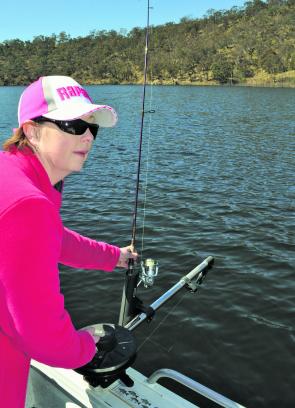
There are many proficiencies required to run a downrigger. After a while you will have a routine that works for you. Don’t let anyone tell you trolling is boring; if you are using a downrigger there is always something to do.
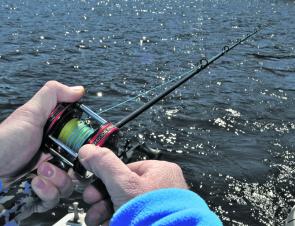
Trolling lures or flies on lead-core line is a very simple yet effective method of chasing trout deep in the water column. Centrepin or overhead reels are most suited to lead core.
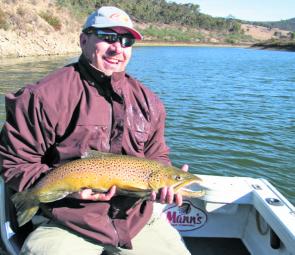
Large brown trout are big drawcards for the trout troller. Controlled-depth techniques are ideal for getting your lures down to where they are feeding.

Rainbow trout are quite pelagic in their behaviour. Deep open water is a great place to search them out using controlled-depth techniques.
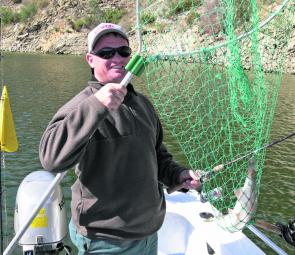
In the bag! Ben Lane caught this Lake Lyell rainbow on a downrigged lure. That’s a paravane at left.

Downriggers come various configurations and sizes with vertical or horizontal spools. The weights or bombs also vary in size and shape.
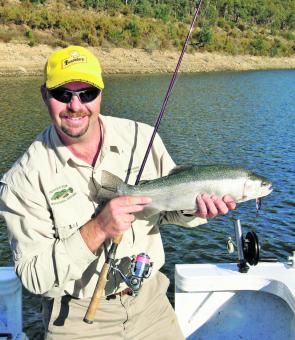
This rainbow fell to a trolled metal spoon. Nothing could be easier than flatline trolling a lure in the upper surface layers.
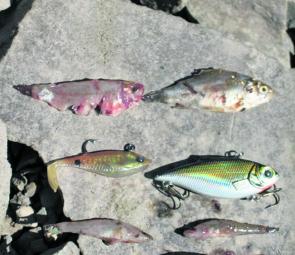
No matter what technique you use, it will pay to match your lure to what the fish are feeding on.

This angler was able to catch these brown trout by watching the sounder and setting lures at very specific depths.
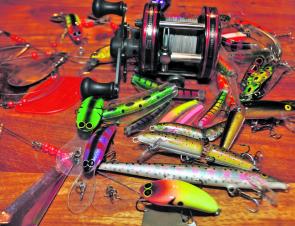
A selection of the author’s trolling tackle.




